Bandle Tale: A League Of Legends Story review: a charming crafting RPG plagued by busywork
Not quite Hamstardew Valley
Riot Forge’s last stab at publishing smaller spin-offs from indie teams has resulted in Bandle Tale: A League Of Legends Story, which at first glance has all the things I love in self-proclaimed cosy games: gorgeous pixel art, laidback objectives and characters cute enough to trigger primal cheek-squishing instincts. But despite looking like an SNES classic and playing like a mix between Animal Crossing and Stardew Valley, Bandle Tale unfortunately ties itself in knots with overly grindy crafting that had me rubbing my temples in an effort not to combust.
Bandle Tale follows the massively popular MOBA’s race of fluffy hamster-like people, the Yordles, though you really don’t need any prior League Of Legends knowledge to jump in. All you need to know is that Yordles live in a set of sky islands and love to party, but one day a malfunction ruins the portal network that connected each floating archipelago.

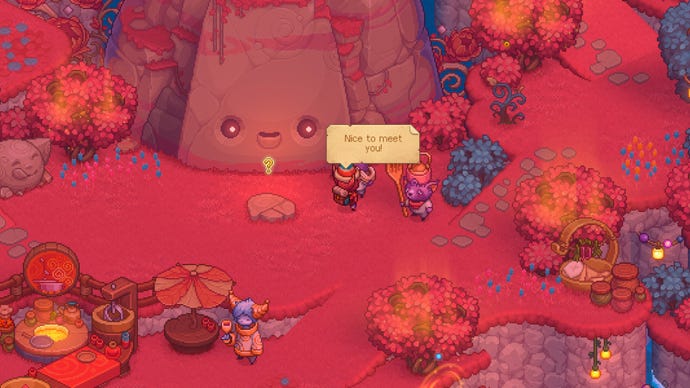
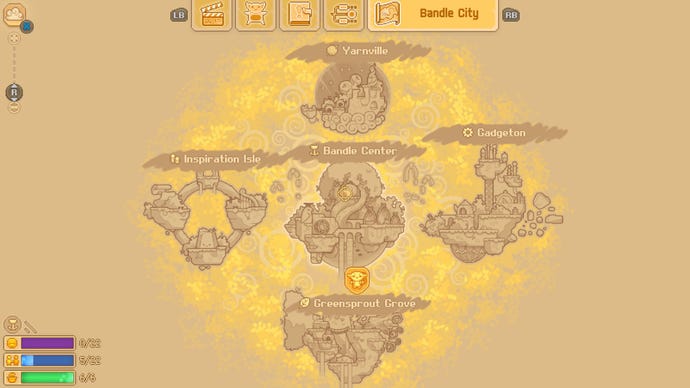
How do you fix such a ruinous malfunction? More parties! You create your own hamster hero before zooming off to each sky island to complete quests, make new friends and then invite said friends to a massive get together. The combined magical force of an entire hamster population, collectively gyrating on the dancefloor and drinking what I assume is non-alcoholic punch, is said to repair the portals. Or something to that effect. So, off you go!
Bandle City describes itself as a “crafting RPG,” which means you’re mainly on the hunt for resources to then build other resources, tools and perennial farming game favourites (workbenches, ovens, seed beds, so on.) Unlike similar games, you’re also not relegated to one static home here. Bandle Tale instead has you lug around a backpack house that can be unzipped in specific areas.
I love the idea of a portable homebase, especially for a game that involves so much travelling back and forth. Despite its carry-on nature, your home here is just as flexible and expansive as you might hope. What initially begins as a one room studio turns into a multi-room bachelor pad by the end, complete with a greenhouse and options to customise the walls, floors, bed frames and window panels.
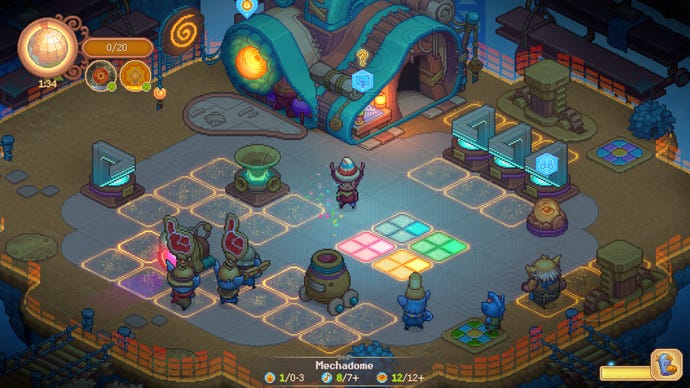
You can also unfurl various carpets outside, revealing a fully-kitted food stand or space for the festivals you’ll be throwing throughout the adventure. Planning for these gatherings is always good fun since, in the case of festivals, you need to match the music, lighting and activities to your guest’s unique tastes. Food stands, on the other hand, play more like a mini Overcooked with your humble hero zooming between the chopping station and the oven to complete orders as quickly as possible.
These parties provide bundles of charm, as do the fluffy inhabitants that you’ll be running errands for. Characters can, surprisingly, be laugh out loud funny (LOL can be LOL, who knew?), and even when quips miss the funny bone, characters still have quirks weird enough to force a smile out of even the most hardened of faces. With such a loveable personality, it’s a shame, then, that the act of crafting things for these cute fur balls also had me rolling my eyes as often as I did.
Levelling up (Inspiration) plays the biggest part in the eyeroll reflex. You'll earn Inspiration for doing absolutely anything, from gathering fruit to completing side quests to playing the fishing mini-game that’s basically identical to Stardew Valley’s. But the more you do a certain task, the less Inspiration points you net from it before you conk out in bed. On paper, Inspiration seems like a great idea. It discourages the grind that often kneecaps games aiming for relaxing vibes above all else, and gently nudges you toward new experiences and activities. Except it doesn't really work in the longrun.
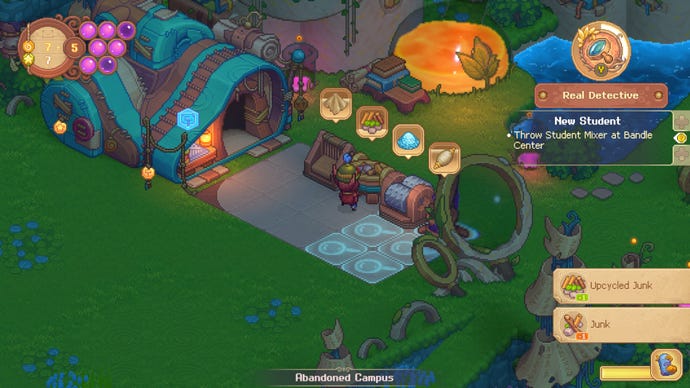
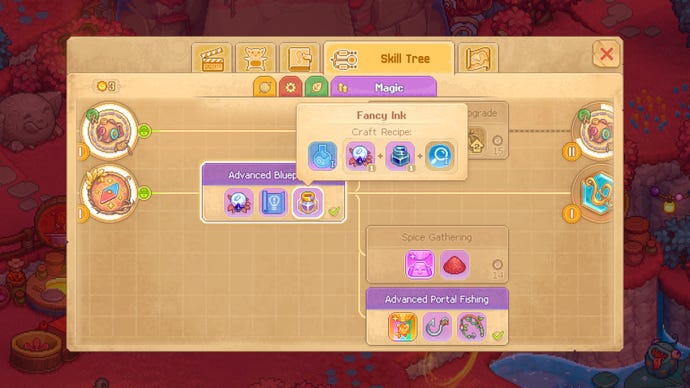
Most quests require certain raw resources like beetroot, or craftable items, like a xylophone, for example. But your ability to craft or scavenge them are locked behind tiers on seemingly never-ending skill trees, which requires a certain amount of Inspiration points to unlock. The trouble is, scavenging and crafting gives out so little Inspiration after, let’s say, your seventh go at picking beets. So, I usually just grinded away in the kitchen and cooked my way to more Inspiration points because it's an activity you’re rarely asked to do outside of hosting food stalls. Since most new quests require items that are locked behind skill tiers, this grind awkwardly repeats for almost the entire game.
Excessive grinding isn’t just relegated to how you level up, though. Crafting in itself is a major chore, which is obviously a massive worry for a crafting game, and it's here where the in-game currency of Stars jumps in to make those eyerolls lengthier. Take clay, as a pretty mundane example. You need five pieces of clay to build a quest-specific item. To get clay, you need to build a clay pump on certain areas. To activate the clay pump, you need a magic rubber loop. To create a rubber loop, you need a bouncy ball. And to create a bouncy ball, you need, urm, clay? Which means grinding for Stars by hosting food stalls and festivals outside of your portable house, all to buy one clump from a specific vendor.
Sure, crafting games all work on the same logic. You usually need X amount of Y to make Z, and that process sometimes repeats itself over and over. But Bandle Tale makes you pass through so many checkpoints that you almost forget that you needed clay in the first place. And we know from other cosy sims that chores can be fun, too. I name dropped Stardew Valley earlier, and although it’s a cliched comparison, it is the genre’s popular cheerleader for a reason. Stardew Valley smartly has you work toward long-term goals to automate tasks in ways that Bandle Tale mostly doesn’t: manual plant-watering in Stardew Valley eventually gets replaced with sprinklers, for instance. But Bandle Tale has you backtrack to collect and create the same resources every single time in ways that can quickly exhaust.
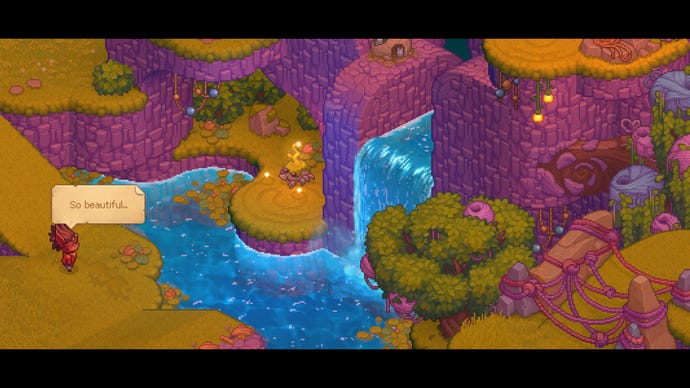
Skill trees don’t iron out the tedium either; they just extend it. New skills just let you gather or create more stuff, rather than change how you experience or plan for future quests. And since quest objectives are almost always about crafting new things, the game can feel more like being trapped on a hamster wheel as you chase stuff to unlock stuff to make more stuff and… you get idea.
There are times, though, when the hamster wheel detaches and rolls you somewhere lovely. Discovering a new sparkly cave, unlocking a different friend’s wholesome hut, or stumbling upon a downside up waterfall is always exciting. And that’s doubly true when it comes to the five sky islands. Whether it was the more mechanical district or the university housing a mini civil war between the arts and sciences faculties, I always looked forward to dusting off a new part of the map.
Not to mention how damn good each of the five islands look, a conclusion that you can probably come to yourself just by glancing at screenshots, so let me gush over some smaller details instead. I love the way islands sometimes contort like the impossible geometry in Monument Valley. I love the way yordles can cling to the sides of buildings, going about daily life or looking through telescopes while upside down. I love the piano bridges that sing a jolly tune along with your footsteps.
Unfortunately, good vibes simply aren’t enough to save Bandle Tale from its overwhelming busywork. It too often gatekeeps the fun behind skill tiers and layers of crafting that never felt totally satisfying to me, but at least the constant repetition etched the beautiful pixels onto my eyeballs. That’s good. I think?
This review is based on a review build of the game provided by publishers Riot Forge.









